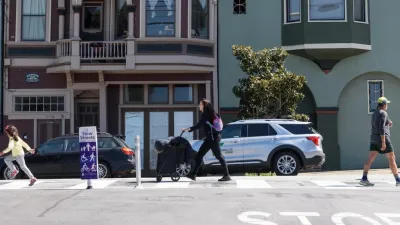In a pictorial essay, Mark Byrnes chronicles the uneven legacy of 50 years of pedestrian malls, and the uncertain future for a redevelopment tool that has been derided in some cities and celebrated in others.
As the movement for complete streets gains momentum across the country, and streets that solely facilitated the flow of automobiles are being redesigned to accommodate a variety of modes, it seems like a good time to consider whether streets conceived of solely for pedestrians should also be rethought.
Byrnes traces the genesis of America's pedestrian malls to the building of the Kalamazoo Mall, designed by no less than enclosed mall pioneer Victor Gruen. Although the fate of Kalamazoo's mall, which became a sore spot with residents and was reopened to traffic in 1998, was shared by many cities and towns who experimented with the concept, success stories such as the Third Street Promenade in Santa Monica and Miami's Lincoln Road Mall muddy the pedestrian mall's legacy.
Byrnes has assembled a slide show of some of the remaining pedestrian malls in cities across the country, such as Sacramento, Boulder, and Charlottesville, Virginia.
FULL STORY: The Uncertain Legacy of America's Pedestrian Malls

Study: Maui’s Plan to Convert Vacation Rentals to Long-Term Housing Could Cause Nearly $1 Billion Economic Loss
The plan would reduce visitor accommodation by 25,% resulting in 1,900 jobs lost.

Alabama: Trump Terminates Settlements for Black Communities Harmed By Raw Sewage
Trump deemed the landmark civil rights agreement “illegal DEI and environmental justice policy.”

Why Should We Subsidize Public Transportation?
Many public transit agencies face financial stress due to rising costs, declining fare revenue, and declining subsidies. Transit advocates must provide a strong business case for increasing public transit funding.

Paris Bike Boom Leads to Steep Drop in Air Pollution
The French city’s air quality has improved dramatically in the past 20 years, coinciding with a growth in cycling.

Why Housing Costs More to Build in California Than in Texas
Hard costs like labor and materials combined with ‘soft’ costs such as permitting make building in the San Francisco Bay Area almost three times as costly as in Texas cities.

San Diego County Sees a Rise in Urban Coyotes
San Diego County experiences a rise in urban coyotes, as sightings become prevalent throughout its urban neighbourhoods and surrounding areas.
Urban Design for Planners 1: Software Tools
This six-course series explores essential urban design concepts using open source software and equips planners with the tools they need to participate fully in the urban design process.
Planning for Universal Design
Learn the tools for implementing Universal Design in planning regulations.
Smith Gee Studio
Alamo Area Metropolitan Planning Organization
City of Santa Clarita
Institute for Housing and Urban Development Studies (IHS)
City of Grandview
Harvard GSD Executive Education
Toledo-Lucas County Plan Commissions
Salt Lake City
NYU Wagner Graduate School of Public Service





























